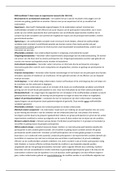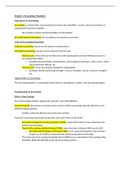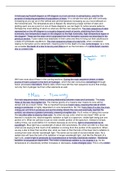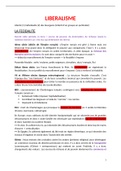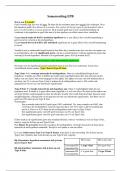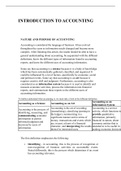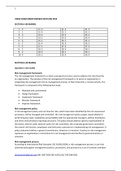Table of content
week 1 quantitative ................................................................................................................................................. 2
1.1 introduction to the course .............................................................................................................................. 2
1.2: causal efference ............................................................................................................................................ 2
1.3 DAG ............................................................................................................................................................... 4
1.4 colliders/ DAGS ............................................................................................................................................. 7
Week 2.................................................................................................................................................................... 10
2.1 OLS and Moderation.................................................................................................................................... 10
2.2 mediation...................................................................................................................................................... 12
2.3 statistical significance .................................................................................................................................. 14
2.4 beyond significance ...................................................................................................................................... 16
Week 3.................................................................................................................................................................... 19
3.1 logistics regression ...................................................................................................................................... 19
3.2 after logistic regression ............................................................................................................................... 20
3.3 DAG and table 2 fallacy .............................................................................................................................. 23
3.4 data don’t drive ............................................................................................................................................ 26
Week 4: qualitative .............................................................................................................................................. 29
4.1 : introduction ............................................................................................................................................... 29
4.2 : What is discourse? ..................................................................................................................................... 29
4.3: different forms of discourse analysis .......................................................................................................... 30
4.4 talking discourse analysis into the field ....................................................................................................... 33
Week 5.................................................................................................................................................................... 34
5.1 Ethnography on Care in Times of Covid-19 ................................................................................................ 34
5.2 ethnography in Healthcare Research .......................................................................................................... 34
5.3 theory in ethnography .................................................................................................................................. 35
5.4 quality in ethnographic research ................................................................................................................. 36
Week 6.................................................................................................................................................................... 37
6.1 what’s the problem? The three reasons for studying associations .............................................................. 37
6.3 what’s your problem? .................................................................................................................................. 42
,week 1 quantitative
1.1 introduction to the course
Main points
Part 1
• Causal inference
• OLS and Logistic regression
• Statistical significance
Part 2
• Discourse analysis
• Ethnography
Questions from today
- What was the question
- What was the underlying question
- What was actually estimated ( geschat)
- How is the estimate really an answer to the question
- What is the estimated, big, small, good?
- What does the researcher conclude
1.2: causal efference
Learning goals from today
- Explain the potential outcomes approach in causal inference and apply it in thinking
about causal effect estimation
- To define causal effects
- To apply the concepts of consistency, positivity and exchangeability in randomized an
non randomized settings.
Example : loreal Paris
Proven clinical results: 70% less imperfection in 4 weeks. 41 women got tested.
They use the words causal effects ( if you use this you get a better skin)
Causal effects = A leads to B. A treatment has a causal effect if the outcome under treatment
1 would be different from the outcome under treatment 2. What would have happened.
There was a problem with the example study
• Small sample à only except under extremely strong assumptions
• Financial by company
• No control groupà this is essential
• Potential regression towards the mean ( mostly you use those product when you skin
is very bad, of course it will be better, it cant be worser)
We are not interested in the outcome but in the roll of treatment. à how many
imperfection women have. We are interested in the role of treatment in achieving this
outcome : less imperfections than without true match minerals
Conclusion: no meaningful causal conclusion can be drawn from this study
,Woman A uses true match minerals : 2 bad spots
Woman a does not use true match minerals : 5 bad spots
Individual treatment effect : 3 spots ( 60%)
Average treatment effect: average of individual effect in a population
Causal effects :
Counterfactual outcomeà potential outcome that is not observed because the subject did
not experience the treatment( could happen if) if I did not drink the coffee I did not burn my
lip.
But there is a solution for al this. We need in a research those 3 to have a causal effect
1- Positivity
à about the example and the way it was composed. A control group.
We don’t need people with or without a lighter because we adjust for smoking
status. We need smokers with/without lighters and non smokers with or without
lighters. Positivity means there have to be a positive probability for everybody in the
sample to assign to each of the treatment levels. In the lighter case positivy seems
oke
2- Consistency
à define if. Clear definition of treatments. Does water kill? What do you mean, kill
when I drink it or drown in it?
à eat broccoli its healthy. What is healthy? How much? How often?
It is about defining the treatment. You need to be very specific when you define an
exposure or a treatment
3- Exchangeability
à does not matter who has the treatment.
à for example the lighters can not switch ( people with a lighter are mostly smokers)
Causal question: what is the effect of carrying a cigarette lighter on health?
Stratificationà you make different strata: healthy people by healthy people, smokers
by smokers etc.
Lighter Without lighter
Healthy 57% 87%
Smokers 50% 50%
Not exchangeable because lighter is not the problem for health. Its probably
smoking, so you need also a strata for smoking.
, RCT
• Select patients
• Randomly assign to treatment groups
• Random: exchangeability
• Random: positivity à because of the randomization they could be in group one but
also in group 2
• Defining interventions: consistency
With RCT you have automatically al the 3 inferences
RCT
• Limited generalizability ( external validity) due to treatment protocol and patient
selection
• Practical ethical considerations
Observational( non randomized ) study
• Real world outcomes
• Availability of data
• Internal validly threatened by lack of exchangeability
• Positivity and consistency need explicit attention
1.3 DAG
In many cases we are interested in causal effect not in just associations
Associationà statistical relationship
Causationà difference between potential outcomes
This association equals this difference if identifiability conditions hold
We need:
• Theory/subject knowledge
• Causal structure
And we design the analysis accordingly
Leaning goals
- Using graph theory assess exchangeability
- To use directed acyclic graphs in the design and evaluation of an analysis
- Rules and terms of a DAG
- To apply concepts confounder, confounding ( traditional and structural)
- Rules and terms of DAG
Adjustment to improve exchangeability
• Small numbers of factors à stratifications is possible
A complete and correct adjustment leads to exchangeability
So what should you adjust for you analyst?
week 1 quantitative ................................................................................................................................................. 2
1.1 introduction to the course .............................................................................................................................. 2
1.2: causal efference ............................................................................................................................................ 2
1.3 DAG ............................................................................................................................................................... 4
1.4 colliders/ DAGS ............................................................................................................................................. 7
Week 2.................................................................................................................................................................... 10
2.1 OLS and Moderation.................................................................................................................................... 10
2.2 mediation...................................................................................................................................................... 12
2.3 statistical significance .................................................................................................................................. 14
2.4 beyond significance ...................................................................................................................................... 16
Week 3.................................................................................................................................................................... 19
3.1 logistics regression ...................................................................................................................................... 19
3.2 after logistic regression ............................................................................................................................... 20
3.3 DAG and table 2 fallacy .............................................................................................................................. 23
3.4 data don’t drive ............................................................................................................................................ 26
Week 4: qualitative .............................................................................................................................................. 29
4.1 : introduction ............................................................................................................................................... 29
4.2 : What is discourse? ..................................................................................................................................... 29
4.3: different forms of discourse analysis .......................................................................................................... 30
4.4 talking discourse analysis into the field ....................................................................................................... 33
Week 5.................................................................................................................................................................... 34
5.1 Ethnography on Care in Times of Covid-19 ................................................................................................ 34
5.2 ethnography in Healthcare Research .......................................................................................................... 34
5.3 theory in ethnography .................................................................................................................................. 35
5.4 quality in ethnographic research ................................................................................................................. 36
Week 6.................................................................................................................................................................... 37
6.1 what’s the problem? The three reasons for studying associations .............................................................. 37
6.3 what’s your problem? .................................................................................................................................. 42
,week 1 quantitative
1.1 introduction to the course
Main points
Part 1
• Causal inference
• OLS and Logistic regression
• Statistical significance
Part 2
• Discourse analysis
• Ethnography
Questions from today
- What was the question
- What was the underlying question
- What was actually estimated ( geschat)
- How is the estimate really an answer to the question
- What is the estimated, big, small, good?
- What does the researcher conclude
1.2: causal efference
Learning goals from today
- Explain the potential outcomes approach in causal inference and apply it in thinking
about causal effect estimation
- To define causal effects
- To apply the concepts of consistency, positivity and exchangeability in randomized an
non randomized settings.
Example : loreal Paris
Proven clinical results: 70% less imperfection in 4 weeks. 41 women got tested.
They use the words causal effects ( if you use this you get a better skin)
Causal effects = A leads to B. A treatment has a causal effect if the outcome under treatment
1 would be different from the outcome under treatment 2. What would have happened.
There was a problem with the example study
• Small sample à only except under extremely strong assumptions
• Financial by company
• No control groupà this is essential
• Potential regression towards the mean ( mostly you use those product when you skin
is very bad, of course it will be better, it cant be worser)
We are not interested in the outcome but in the roll of treatment. à how many
imperfection women have. We are interested in the role of treatment in achieving this
outcome : less imperfections than without true match minerals
Conclusion: no meaningful causal conclusion can be drawn from this study
,Woman A uses true match minerals : 2 bad spots
Woman a does not use true match minerals : 5 bad spots
Individual treatment effect : 3 spots ( 60%)
Average treatment effect: average of individual effect in a population
Causal effects :
Counterfactual outcomeà potential outcome that is not observed because the subject did
not experience the treatment( could happen if) if I did not drink the coffee I did not burn my
lip.
But there is a solution for al this. We need in a research those 3 to have a causal effect
1- Positivity
à about the example and the way it was composed. A control group.
We don’t need people with or without a lighter because we adjust for smoking
status. We need smokers with/without lighters and non smokers with or without
lighters. Positivity means there have to be a positive probability for everybody in the
sample to assign to each of the treatment levels. In the lighter case positivy seems
oke
2- Consistency
à define if. Clear definition of treatments. Does water kill? What do you mean, kill
when I drink it or drown in it?
à eat broccoli its healthy. What is healthy? How much? How often?
It is about defining the treatment. You need to be very specific when you define an
exposure or a treatment
3- Exchangeability
à does not matter who has the treatment.
à for example the lighters can not switch ( people with a lighter are mostly smokers)
Causal question: what is the effect of carrying a cigarette lighter on health?
Stratificationà you make different strata: healthy people by healthy people, smokers
by smokers etc.
Lighter Without lighter
Healthy 57% 87%
Smokers 50% 50%
Not exchangeable because lighter is not the problem for health. Its probably
smoking, so you need also a strata for smoking.
, RCT
• Select patients
• Randomly assign to treatment groups
• Random: exchangeability
• Random: positivity à because of the randomization they could be in group one but
also in group 2
• Defining interventions: consistency
With RCT you have automatically al the 3 inferences
RCT
• Limited generalizability ( external validity) due to treatment protocol and patient
selection
• Practical ethical considerations
Observational( non randomized ) study
• Real world outcomes
• Availability of data
• Internal validly threatened by lack of exchangeability
• Positivity and consistency need explicit attention
1.3 DAG
In many cases we are interested in causal effect not in just associations
Associationà statistical relationship
Causationà difference between potential outcomes
This association equals this difference if identifiability conditions hold
We need:
• Theory/subject knowledge
• Causal structure
And we design the analysis accordingly
Leaning goals
- Using graph theory assess exchangeability
- To use directed acyclic graphs in the design and evaluation of an analysis
- Rules and terms of a DAG
- To apply concepts confounder, confounding ( traditional and structural)
- Rules and terms of DAG
Adjustment to improve exchangeability
• Small numbers of factors à stratifications is possible
A complete and correct adjustment leads to exchangeability
So what should you adjust for you analyst?


